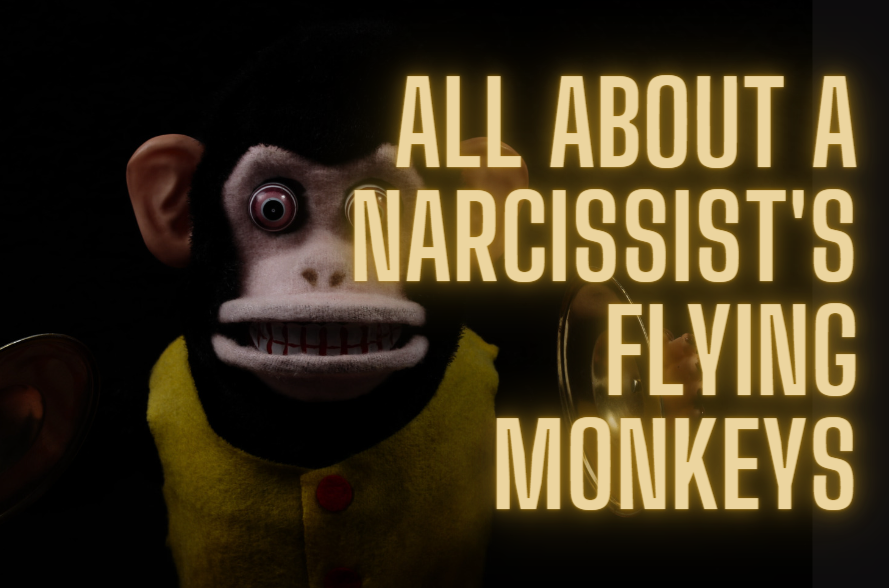Introduction
The narcissistic personality disorder (NPD) is a significant area of concern in the field of psychology due to its pervasive impact on relationships. Characterized by an inflated sense of self-importance, a deep need for excessive attention and admiration, and a lack of empathy for others, individuals with NPD often have troubled relationships with those around them. But what becomes increasingly complex is when the concept of “flying monkeys” comes into play.
“Flying monkeys” is a term used within the mental health community to describe individuals who are manipulated by narcissists to do their bidding. This term, inspired by the minions of the Wicked Witch of the West in the classic movie “The Wizard of Oz”, helps in painting a vivid picture of how narcissists operate, often creating an army of unwitting accomplices to further their agenda.
Navigating relationships with narcissists and their flying monkeys can be extremely challenging due to the complex web of manipulation, deceit, and power dynamics that are typically involved. This article will delve into these dynamics, providing a comprehensive guide to recognizing, navigating, and healing from such relationships. The goal is to equip individuals with the knowledge and tools necessary to protect themselves and reclaim their independence.
Understanding Narcissism and Narcissistic Relationships
Narcissism, at its core, is a personality disorder characterized by grandiosity, a lack of empathy, and a need for admiration. People with NPD believe they are superior and have little regard for other people’s feelings. However, beneath this mask of extreme confidence lies a fragile self-esteem that’s vulnerable to the slightest criticism.
Narcissists often develop intricate relationships centered around their needs and desires, paying little heed to the needs of others involved. These relationships are defined by a distinct power dynamic where the narcissist wields control, often through manipulation and emotional coercion. The balance of power is skewed, leading to a toxic environment that can be psychologically damaging for those involved.
The narcissistic relationship’s complexity is deep-rooted, often making it challenging to identify, especially when one is ensnared within its confines. One common characteristic is the narcissist’s propensity to maintain control at all times. This control can manifest in various ways, including excessive criticism, emotional manipulation, and even gaslighting. Gaslighting, a form of psychological manipulation, involves the narcissist making someone question their reality, leading to confusion and self-doubt.
Victims in narcissistic relationships often feel entrapped, dealing with constant turbulence and confusion. They may question their own perception of events due to the manipulative tactics of the narcissist, leading to a sense of lost self-identity and self-worth. It’s essential to recognize these signs and understand the mechanics behind such relationships to navigate and, when necessary, exit them.
As we delve deeper into this subject, the term “flying monkeys” gains relevance. This concept enhances our comprehension of the structures built by narcissists, further complicating the relationship dynamic.
Unpacking the Concept of “Flying Monkeys”
“Flying monkeys” is a term steeped in allegory, derived from L. Frank Baum’s iconic novel, “The Wizard of Oz.” The moniker, embraced by psychologists and therapists, describes individuals who have been manipulated by a narcissist to serve their interests, often without realizing the part they are playing in the narcissist’s manipulative game.
The function of flying monkeys within the narcissistic dynamic is quite complex. In many instances, they are unaware of the role they play, believing that they are helping a friend or loved one. Narcissists are skilled at portraying themselves as the victim and using this narrative to manipulate their flying monkeys into supporting their cause or engaging in harmful actions against the true victim.
Flying monkeys can be anyone—a friend, a family member, or a coworker. They are not necessarily malevolent. More often than not, they are unsuspecting participants in the narcissist’s grand scheme, ensnared by the narcissist’s convincing tales of victimhood and pleas for assistance.
The effects of being a flying monkey can be distressing. They may find themselves in the middle of conflicts without understanding why or how they got there. They may feel guilty for actions they have taken under the narcissist’s influence, leading to self-doubt and confusion. In some cases, flying monkeys may even mimic the narcissist’s behavior, becoming secondary sources of pain for the true victim.
Recognizing the role and function of flying monkeys is a crucial step towards understanding and navigating relationships with narcissists. In the next section, we’ll discuss how to identify these dynamics in real-life relationships.
Identifying Narcissists and Their Flying Monkeys in Your Life
The ability to identify narcissists and their flying monkeys can be a significant game-changer in navigating and mitigating the impacts of narcissistic relationships. It requires a keen understanding of the key characteristics and behaviors associated with these roles.
Narcissists, as previously mentioned, display a grandiose sense of self-importance and require constant admiration. They show a lack of empathy, frequently belittle others, and manipulate situations to maintain control. Identifying a narcissist may be straightforward in some cases, but more often than not, it requires recognizing patterns of manipulative behavior that may be subtle and insidious.
Flying monkeys, on the other hand, may be harder to identify as they often don’t realize they are being manipulated. However, there are some red flags to watch out for. For example, if an individual is frequently involved in conflicts or always seems to be acting on behalf of the narcissist, they may be acting as a flying monkey.
It is also essential to be aware of manipulation tactics, such as gaslighting, projection, and playing the victim, which are often used by narcissists to control both the primary victim and the flying monkeys. Recognizing these tactics can be a powerful tool in breaking free from the cycle of narcissistic abuse.
Differentiating between a genuine relationship and a narcissist’s manipulation can be complex, but understanding the dynamics at play is an essential first step. Knowledge, in this context, is power – the power to protect oneself, make informed decisions, and find the most effective path towards healing. Up next, we will explore strategies for navigating relationships with narcissists and their flying monkeys.
Navigating Relationships with Narcissists and Their Flying Monkeys
The journey of navigating relationships with narcissists and their flying monkeys can be daunting. It involves walking a tightrope between self-preservation and the potential emotional turmoil that may come with distancing oneself from such relationships. However, with the right strategies, one can successfully manage these complex dynamics.
Setting boundaries is a critical first step. By asserting and maintaining these limits, one can begin to regain control in the relationship. These boundaries can be emotional, such as refusing to engage with the narcissist’s manipulative tactics, or physical, like limiting the time spent with the narcissist or their flying monkeys.
Psychological strategies also play a crucial role in navigating these relationships. This can include techniques such as grey rocking, a method of interaction that involves giving minimal response to the narcissist’s attempts at manipulation, effectively making oneself less interesting to the narcissist. Another method is understanding and validating one’s emotions, acknowledging that it’s okay to feel hurt, confused, or angry about the situation.
Self-care is equally important in managing these relationships. This can involve taking time for personal interests and hobbies, maintaining a healthy lifestyle, and reaching out to supportive friends or family members. Self-care practices contribute to mental resilience, providing the strength to withstand the emotional strain these relationships can cause.
In certain cases, seeking professional help may be necessary. Therapists and psychologists trained in dealing with narcissistic relationships can provide valuable insight and techniques to manage and eventually escape from the manipulative grip of the narcissist.
The ultimate goal should be to ensure personal well-being and mental health while dealing with these complex relationships. The following section will delve into how one can safely disengage and heal from such relationships.
Ending Relationships with Narcissists and Their Flying Monkeys
While navigating relationships with narcissists and their flying monkeys can be an essential part of the journey, there may come a time when ending these relationships becomes necessary for one’s mental and emotional well-being. The process of disengagement, while challenging, can also provide an empowering path to recovery and healing.
The first step towards ending such relationships is to disengage safely. This can involve gradually reducing contact with the narcissist and their flying monkeys or, in some cases, choosing to cut off contact entirely. It’s vital to remember that this process should be done at a pace that feels safe and manageable.
Healing and recovering from narcissistic abuse is a journey of its own. It’s a process that involves acknowledging the trauma, understanding the dynamics that were at play, and ultimately, working towards regaining one’s self-identity and self-esteem. This process can take time and patience, but it’s a necessary part of healing.
A support network plays a crucial role during and after disengagement. This can be composed of trusted friends, family members, or a professional counselor. They can provide validation, emotional support, and practical advice during this challenging time.
Choosing to end relationships with narcissists and their flying monkeys can be a complex and emotionally draining decision. However, it’s a step that can pave the way towards a healthier and happier life, free from the web of manipulation and control. It’s a journey towards self-empowerment, signifying the end of one chapter and the beginning of another, brighter one. As we conclude, let’s revisit the key points and understand why they matter in the broader context of dealing with narcissistic relationships.
Conclusion
Navigating the intricacies of relationships with narcissists and their flying monkeys can undoubtedly be challenging. It requires an understanding of the nature of narcissism, the ability to identify narcissists and their flying monkeys, and the skills to navigate, and when necessary, terminate such relationships. Each of these aspects forms a crucial part of the journey towards understanding, managing, and healing from the effects of narcissistic relationships.
Throughout this discourse, we have seen the characteristics that define narcissists and their flying monkeys, the tactics they employ, and the impacts they have on their victims. Recognizing these dynamics and knowing how to handle them can equip individuals with the tools needed to protect their mental and emotional well-being.
It’s important to remember that those caught in the crossfire of narcissistic relationships are not alone. Numerous resources, support groups, and professionals are available to help navigate these complex situations. Ultimately, the goal should be to prioritize self-care and personal well-being, acknowledging that everyone deserves respect, kindness, and genuine relationships.
Let’s take a final look at some resources and further reading materials that can be helpful for those seeking to understand more about narcissists and their flying monkeys, or for those who are looking to find help.
References & Further Reading
The journey of understanding, navigating, and healing from relationships with narcissists and their flying monkeys can be greatly facilitated by further education and support. To this end, a number of resources and materials can be recommended, each offering unique insights and guidance.
There is a vast array of scholarly articles and research papers that delve into the intricacies of narcissistic personality disorder and its impact on relationships. In addition, several books provide comprehensive guides on how to manage and heal from narcissistic relationships.
Online platforms can also offer valuable resources. Various websites, blogs, and forums focus on narcissistic abuse, providing a platform for sharing experiences, seeking advice, and finding comfort in a supportive community.
Support groups, both online and in-person, can be invaluable during the recovery process. They offer a safe space for individuals to share their experiences, learn from others, and gain the strength to navigate their healing journey.
Professional help should also be considered when dealing with narcissistic relationships. Therapists and psychologists trained in this field can provide personalized guidance and therapeutic strategies to cope with and recover from these relationships.
While the journey might be challenging, it’s crucial to remember that help is available, and recovery is possible. The pursuit of knowledge, coupled with support and professional guidance, can make the process more manageable and, ultimately, pave the way towards healing and recovery.





